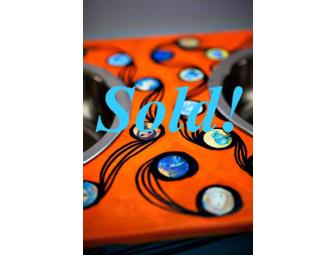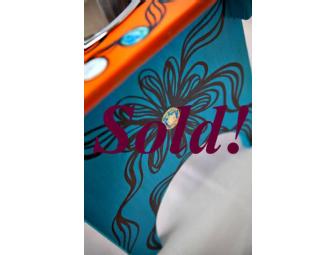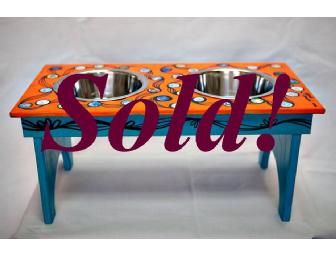For Your Pet
Large Dog Feeding Station by Gloria Muriel
- Item Number
- 146
- Opening Bid
- 100 USD
Item Description
THIS STAND HAS BEEN SOLD! PLEASE DO NOT BID ON THIS STAND! THANK YOU!
Adorable set of stands by Gloria Muriel. Her paintings, primarily acrylics, are characterized by their dazzling color and enigmatic, symbol-rich iconography. The work is predominated by images of big-eyed girls, often playing musical instruments; birds, and anthropomorphized nature, like trees and flowers with faces. The little stickers on the stands are images taken from her paintings. ***This auction for Large Dog stand only***
Item Special Note
This stand is a unique one-of-a-kind piece of art! Because all stands and artwork have been sealed, they can easily be wiped down with a damp towel for easy cleaning. It is recommended that all stands be used indoors as a precaution against the elements.
Each stand comes with two stainless steel water and food bowls (2 quart for large dog stands, 1 pint for small dog/cat stands).
Approximate dimensions (all dimensions are approximations):
- Large Dog Feeding Stations: Height 11”, Width 24”, Depth 12”
- Small Dog or Cat Feeding stations: Height 5”, Width 18”, Depth 9”
Purchased stands may be picked up from the FACE Foundation office or shipped to buyers (shipping costs will apply).
Artist Bio:
Painter Gloria Muriel:
Pop Surrealism on a Spiritual Quest
Painter Gloria Muriel's work conveys a glowing immediacy, yet evokes timeless, remote worlds of mystery and allure. Her paintings, primarily acrylics, are characterized by their dazzling color and enigmatic, symbol-rich iconography. The work is predominated by images of big-eyed girls, often playing musical instruments; birds, and anthropomorphized nature, like trees and flowers with faces. Most of these compositions have a dense, murky background that suggests tangled vegetation or water.
Gloria says the prevalence of young girls in her work probably refers to her inner child and hearkens back to the time in her life that was most idyllic. Though she had a happy childhood, she was also something of a loner and cultivated a rich inner world. This might explain the melancholy look of the girls in the pictures, alone with their thoughts and absorbed in their music, even as they commune with nature.
This mingling of dark and precious iconography, in otherworldly settings, is largely responsible for the paradoxical moods her work evokes an intertwining of sadness and joy; of lightness and gravity that intrigues more than it comforts. Perhaps the uneasiness threaded all through Gloria's work, from the most seemingly innocuous pictures to the freakiest, serve to express her belief in a larger, cosmic sadness, which envelops the variable moods of every individual. "In the end you're alone," she says. "No matter what, you have to cope with life on your own."
The spiritual/mystical dimension of Gloria's paintings is salient, with recurring elements that suggest pantheism or animism -the belief that a divine presence inhabits everything around us. Nature is truly alive in her paintings, and the girls depicted, with their meditative expressions, seem utterly responsive to their animated landscape and supremely calm as the chaos of nature surrounds them.
Some of the spiritual iconography in Gloria's work is overt and draws on her research into dreams and symbols. One piece shows the goddess Lakshmi, another young girl, this one with three eyes. In Hinduism, the third eye, also called the "eye of the heart," represents spiritual perception. Many other religions revere the eye as a symbol of magical, visionary power.
Gloria, a native of Mexico, lives in San Diego and is a graphic designer by trade. She has two daughters ages 11 and 12, which is the same general age as the girls in her pictures ("a coincidence," she says, slyly).
Much of Gloria's work shows the influence of illustration and is reminiscent of the pop surrealism championed by the influential magazine Juxtapoz. She cites Dali as a major influence, which is evident in her vivid palette and fantastical images. Her personal vision, though, comes through powerfully in each picture and anchors the work soundly within the realm of fine arts.



